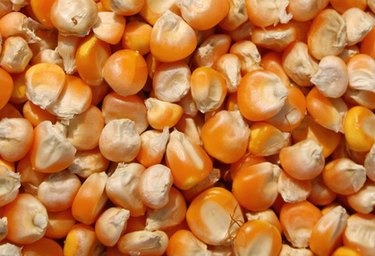
The corn seed is broken down into three main structural components. The first component of the seed is the outer coating, with two layers protecting the baby plant and starchy food within. Below these layers is the endosperm, and finally, at the innermost of the corn seed, is the tiny embryo, or baby plant, of the corn seed.
Outer Covering
Video of the Day
The outer covering of a corn seed is made up of two parts, an outer layer called the pericarp and the inner layer called the testa or true seed coat. This is the fibrous part of the corn seed and, when separated from the rest of the seed, is used in cattle feed, combustion fuels and corn fiber gums, among other food and scientific uses.
Video of the Day
Endosperm
The endosperm of the corn seed makes up more than 60 percent of the total mass of the corn seed. This part of the seed is almost entirely starch, except in sweet corn in which there is a larger amount of sugars. The endosperm is full of moisture in its raw form, but when dried and processed, this is the part of the seed used for milling and grinding into grits, meals and flours for culinary and other uses.
Embryo
The embryo lies to one side of the innermost corn seed and contains the parts of the miniature plant structure, or seedling, in the seed. This is the part of the seed that develops into a new plant if the seed is planted. The plumule, or part that develops into a shoot and produces the first true leaves of a new plant; the radicle or future seedling root; and the coleoptile and colerohiza, or coatings that protect the new seedling are found in this part of the seed. Most of the oil in a corn seed exists in the embryo.